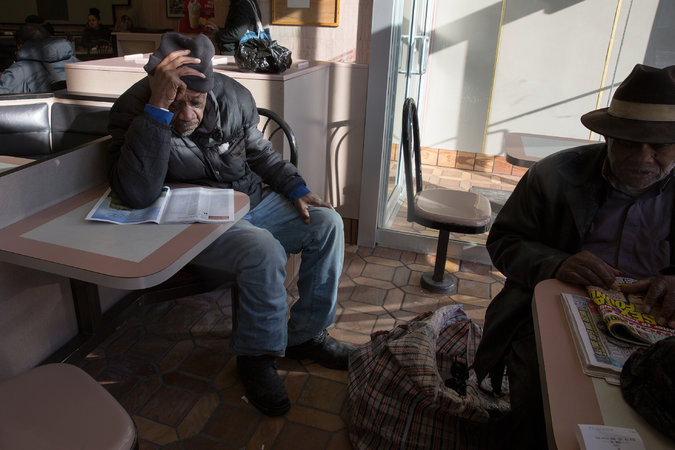With its low coffee prices, plentiful tables and available bathrooms, McDonald’s restaurants all over the country, and even all over the world, have been adopted by a cost-conscious set as a coffeehouse for the people, a sort of everyman’s Starbucks.

Behind the Golden Arches, older people seeking company, schoolchildren putting off homework time and homeless people escaping the cold have transformed the banquettes into headquarters for the kind of laid-back socializing once carried out on a park bench or brownstone stoop.
But patrons have also brought the mores of cafe culture, where often a single purchase is permission to camp out with a laptop. Increasingly, they seem to linger over McCafe Lattes, sometimes spending a lot of time but little money in outlets of this chain, which rose to prominence on a very different business model: food that is always fast. And so restaurant managers and franchise owners are often frustrated by these, their most loyal customers. Such regulars hurt business, some say, and leave little room for other customers. Tensions can sometimes erupt.
In the past month, those tensions came to a boil in New York City. When management at a McDonald’s in Flushing, Queens, called thepolice on a group of older Koreans, prompting outrage at the company’s perceived rudeness, calls for a worldwide boycott and a truce mediated by a local politician, it became a famous case of a struggle that happens daily at McDonald’s outlets in the city and beyond.
Is the customer always right — even the ensconced penny-pincher? The answer seems to be yes among the ones who do the endless sitting.
If Mike Black’s friends are looking for him, they know to check the McDonald’s on Utica Avenue in East Flatbush, Brooklyn, he said. That is where Mr. Black, who is in his 50s, spends hours reading his junk mail.
I don’t eat fast food,” he said, arguing that his one coffee entitled him to all the leisure time he needed. I just come here to hang out and deal with my mail.”
A few miles away at another McDonald’s, a fedora-wearing crew holds court daily. Old-timers, we have been here for years; we’re kids who grew up in the neighborhood,” said Jerry Walters, 70, who was sitting with two friends. On the tables there was nary a coffee, but there was a Budweiser secreted in a paper bag. We’re accustomed to being here.”
McDonald’s is not alone in navigating this tricky territory. Last year, a group of deaf patrons sued Starbucks after a store on Astor Place in Lower Manhattan forbade their meet-up group to convene there, complaining they did not buy enough coffee. Spending the day nursing a latte is behavior reinforced by franchises like Starbucks and others that seem to actively cultivate it, offering free Wi-Fi that encourages customers to park themselves and their laptops for hours.
There is a social benefit to such spots, some experts said.
As long as there have been cities, these are the kind of places people have met in,” said Don Mitchell, a professor of urban geography at Syracuse University and the author of The Right to the City: Social Justice and the Fight for Public Space.”
Whether they have been private property, public property or something in between,” he said, taking up space is a way to claim a right to be, a right to be visible, to say, ‘We’re part of the city too.’ ”
At some of New York City’s 235 McDonald’s outlets, customers say they have adopted the fast-food franchise as a cafe for a less affluent crowd.
We’re pleased many of our customers view us as a comfortable place to spend time,” Lisa McComb, a spokeswoman for the company, said in an email, citing free Wi-Fi and areas for children to play as part of the appeal.
But the leisurely cafe culture and the business plan behind fast food are in opposition. Although signs hang in many McDonald’s stores instructing customers to spend half an hour or less at the tables, Ms. McComb said there was no national policy about discouraging longtime sitting. The individual franchisees do what they feel is best for their community businesses,” she said. In the case of Flushing, that franchisee welcomed those guests for years, and it was only when other customers felt they were no longer welcome that he attempted to adjust the visit time with the customers.”
McDonald’s has even marketed explicitly to the older crowd, most memorably in a television commercial broadcast in 2010, in which a couple of elderly gentlemen who have a standing breakfast date swoon like teenagers when a lovely gray-haired woman starts showing up.
One afternoon last week, Vincent Diehel, 39, sat at his usual table in a McDonald’s near St. Marks Place in Manhattan, scribbling spontaneous bop prosody and then rapping violent lyrics aloud. He was back even though police officers had asked him to vacate after hours of sitting the weekend before, he said.
I wouldn’t leave; I refused to move,” said Mr. Diehel, who said he had fallen on hard times and saw McDonald’s as a refuge where he could gather his thoughts. He felt being kicked out was unfair. I wasn’t ordering no food, no soda, no coffee, no beverages nor any of that,” he said. That’s probably the reason why.”
Police involvement, however, is the exception. For the most part, longtime sitters said they were left alone.
A McDonald’s in Flatbush, Brooklyn, benignly hosts a group of older West Indian women and their shopping carts every afternoon, said Okera Correia, 30, a stagehand and frequent customer. After a while they become invisible, other than the zone around them that nobody wants to sit in,” he said. They become fixtures there.”
Sango Pak, who was back at the Flushing McDonald’s a week after the uproar there, said convening at McDonald’s staved off sadness. You feel lonely and bored when you are home,” he said. Here you talk with these friends.”
In a McDonald’s near Astor Place, a sign explained that customers were entitled to just 20 minutes of sitting time.
But Raymos Martinez, an artist, sat tucked into a dog-eared paperback of historical fiction, and said the anonymity of the place held some appeal. McDonald’s, it’s more like a bus stop. Nobody notices you.”
Or maybe they do. On the other side of the restaurant, in her uniform cap with the Golden Arches, Samantha Reyes, 39, swept discarded burger wrappers off the floor. She refuses to kick out those who seem to find refuge in her McDonald’s.
For myself, I could be in the same situation,” she said. Tomorrow, it could be me.





